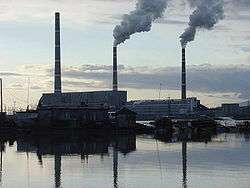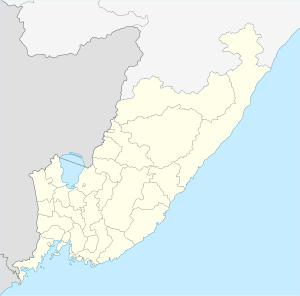Luchegorsk
| Luchegorsk (English) Лучегорск (Russian) | |
|---|---|
| - Urban-type settlement - | |
 Electric power station in Luchegorsk | |
.svg.png) Location of Primorsky Krai in Russia | |
 Luchegorsk | |
|
| |
| Administrative status | |
| Country | Russia |
| Federal subject | Primorsky Krai |
| Administrative center of | Pozharsky District[1] |
| Statistics | |
| Population (2010 Census) | 21,004 inhabitants[2] |
| Time zone | VLAT (UTC+10:00)[3] |
| Founded | 1966 |
| Luchegorsk on Wikimedia Commons | |
Luchegorsk (Russian: Лучего́рск) is an urban locality (an urban-type settlement) and the administrative center of Pozharsky District of Primorsky Krai, Russia. Population: 21,004 (2010 Census);[2] 22,365 (2002 Census);[4] 21,825 (1989 Census).[5]
History
It was founded in 1966 on the bank of the Kontrovod River.
Economy
There is a large electric power station which supplies the electricity to Primorsky Krai and causes ecological problems in Luchegorsk. It is the closest settlement to where the Sino-Soviet border conflict occurred.
Miscellaneous
Luchegorsk is the largest inhabited locality in the Far Eastern Federal District which does not have town status.[2] In September 2015, The Guardian reported that 'dozens of hungry bears' had besieged the town, wandering the streets and attacking residents.[6]
References
- ↑ Государственный комитет Российской Федерации по статистике. Комитет Российской Федерации по стандартизации, метрологии и сертификации. №ОК 019-95 1 января 1997 г. «Общероссийский классификатор объектов административно-территориального деления. Код 05 234», в ред. изменения №259/2014 от 12 декабря 2014 г.. (State Statistics Committee of the Russian Federation. Committee of the Russian Federation on Standardization, Metrology, and Certification. #OK 019-95 January 1, 1997 Russian Classification of Objects of Administrative Division . Code 05 234, as amended by the Amendment #259/2014 of December 12, 2014. ).
- 1 2 3 Russian Federal State Statistics Service (2011). "Всероссийская перепись населения 2010 года. Том 1" [2010 All-Russian Population Census, vol. 1]. Всероссийская перепись населения 2010 года (2010 All-Russia Population Census) (in Russian). Federal State Statistics Service. Retrieved June 29, 2012.
- ↑ Правительство Российской Федерации. Федеральный закон №107-ФЗ от 3 июня 2011 г. «Об исчислении времени», в ред. Федерального закона №271-ФЗ от 03 июля 2016 г. «О внесении изменений в Федеральный закон "Об исчислении времени"». Вступил в силу по истечении шестидесяти дней после дня официального опубликования (6 августа 2011 г.). Опубликован: "Российская газета", №120, 6 июня 2011 г. (Government of the Russian Federation. Federal Law #107-FZ of June 31, 2011 On Calculating Time, as amended by the Federal Law #271-FZ of July 03, 2016 On Amending Federal Law "On Calculating Time". Effective as of after sixty days following the day of the official publication.).
- ↑ Russian Federal State Statistics Service (May 21, 2004). "Численность населения России, субъектов Российской Федерации в составе федеральных округов, районов, городских поселений, сельских населённых пунктов – районных центров и сельских населённых пунктов с населением 3 тысячи и более человек" [Population of Russia, Its Federal Districts, Federal Subjects, Districts, Urban Localities, Rural Localities—Administrative Centers, and Rural Localities with Population of Over 3,000] (XLS). Всероссийская перепись населения 2002 года [All-Russia Population Census of 2002] (in Russian). Retrieved August 9, 2014.
- ↑ Demoscope Weekly (1989). "Всесоюзная перепись населения 1989 г. Численность наличного населения союзных и автономных республик, автономных областей и округов, краёв, областей, районов, городских поселений и сёл-райцентров" [All Union Population Census of 1989: Present Population of Union and Autonomous Republics, Autonomous Oblasts and Okrugs, Krais, Oblasts, Districts, Urban Settlements, and Villages Serving as District Administrative Centers]. Всесоюзная перепись населения 1989 года [All-Union Population Census of 1989] (in Russian). Институт демографии Национального исследовательского университета: Высшая школа экономики [Institute of Demography at the National Research University: Higher School of Economics]. Retrieved August 9, 2014.
- ↑ The Guardian, 'Hungry bears in reign of terror,' New Zealand Sunday Star-Times, September 6, 2015, B13.